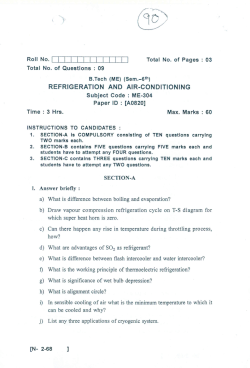
MISHIMOTO ENGINEERING REPORT
2015 Subaru Top-Mount Intercooler RESEARCH & DEVELOPMENT MISHIMOTO ENGINEERING REPORT Subject: 2015 Subaru Top-Mount Intercooler Page 1 of 9 Copyright 2015 Mishimoto Automotive. All rights reserved. Testing of the 2015 Subaru Top-Mount Intercooler Test Vehicle 2015 Subaru WRX 6-Speed First test was all stock. Second test was with a stage 2 setup, which includes the Mishimoto Intake, Mishimoto Down pipe, and Mishimoto Stage 2 tune. Objective: To make a performance intercooler that is a direct fit for the 2015+ WRX. Testing Conditions: The ambient temperature on the day of testing was approximately 65°F (18˚C) with 20% humidity. Apparatus: For hardware Mishimoto chose the PLX sensor modules driven by the Kiwi WiFi plus iMFD. This is a wireless system from the sensor modules to an iPad or laptop computer. The software used was the Palmer Performance Scan XL Professional, which has full data logging capabilities. Figure 1: PLX devices and sensors were used to obtain all testing data. Figure 2: PLX Kiwi Wifi device Page 2 of 9 Copyright 2015 Mishimoto Automotive. All rights reserved. 2015 Subaru Top-Mount Intercooler RESEARCH & DEVELOPMENT 2015 Subaru Top-Mount Intercooler RESEARCH & DEVELOPMENT Figure 3: Palmer Performance Scan XL software was used to record testing data. Air temperatures were measured using sensors that were mounted to the inlet and outlet of the intercoolers. Pressure sensors were also mounted to the inlet and outlet to determine overall pressure drop. A blower fan rated at 4,000 CFM was placed on top of the intercooler during all testing. Research and Development To ensure that an effective intercooler was chosen, we sampled and tested two different core styles. The first core was a “tight” setup featuring relatively small bar-and-fin heights. In theory, the more fins you can compact into a heat exchanger, the more heat transfer capability it will have. The catch to this is that a working fluid (air) must be able to effectively pass through the core at an acceptable rate. If a core is too tight the air will route around the core instead of through it, since moving air will take the path of least resistance. An effective design for a heat exchanger core must therefore balance core density and realistic airflow capabilities. Our testing showed that the first “tighter” core was still more effective compared to the stock top-mount intercooler, but it was not as effective as the second “looser” Mishimoto intercooler. Additional information on the R&D phase of this project can be found on the Mishimoto Blog here: http://engineering.mishimoto.com/?cat=211 Page 3 of 9 Copyright 2015 Mishimoto Automotive. All rights reserved. Experiment Core Testing Cold air is denser than hot air and will therefore allow a larger combustion while also reducing the chances of engine knock. As the intake air becomes colder, a tuner can load a more aggressive timing map into the vehicle’s ECU, which will directly result in more power. An intercooler’s primary function is to reduce the intake temperature significantly and with the best possible efficiency. This requires a large amount of heat transfer with the least possible pressure drop. Utilizing a larger core and optimizing the intercooler’s fin style achieves this goal. To test the design effectiveness of the Mishimoto intercooler, we put the WRX on a dynamometer and measured parameters such as inlet/outlet air temperatures and pressures, as well as the ambient air temperature entering the intercooler. We were also able to see the power and torque output of the vehicle with each of the different intercoolers. The first objective was to choose which core would be used for the final Mishimoto TMIC. To determine this, the outlet temperatures and efficiencies of each unit were compared against each other to evaluate which core had the greatest cooling capability. The outlet temperatures obtained during a 3rd-gear pull (from 2,800 to 6,700 rpm) are shown in Figure 4. Figure 4: Outlet temperatures of the stock TMIC compared to the two prototype Mishimoto cores Page 4 of 9 Copyright 2015 Mishimoto Automotive. All rights reserved. 2015 Subaru Top-Mount Intercooler RESEARCH & DEVELOPMENT As seen in Figure 4, the three units begin with similar outlet temperatures. The stock TMIC begins to lose efficiency at roughly 4,500 rpm and steadily climbs upward for the duration of the dyno pull, whereas both Mishimoto cores temperatures remain relatively linear. It’s clear that the first core slightly outperforms the second core and was therefore the chosen design. TMIC Testing Once a core was selected for the Mishimoto TMIC the next step was to test our unit versus the stock TMIC. As mentioned above, a more effective and efficient intercooler will be able to handle a more aggressive tune since charge-air temperatures will be cooler. Previous testing has shown that a performance intercooler will not have as large an impact from a power standpoint on the stock tune (compared to a tuned car), and the 2015 WRX was no exception. Both the stock TMIC and Mishimoto TMIC were tested on a completely stock car, and while the Mishimoto TMIC was more efficient and supplied lower outlet temps, the power figures remained relatively constant. Next, the Mishimoto performance intake, downpipe, and Stage 2 tune were installed on the WRX and the same testing was performed. As pressure increases in a turbocharged system the overall temperatures increase as well. The Stage 2 tune runs slightly higher boost pressures compared to the stock tune and will therefore provide a better comparison of heat rejection capabilities and efficiencies for each intercooler. Both the Mishimoto TMIC and stock TMIC were installed on the WRX, and five 3rd-gear dyno pulls were performed with equally spaced intervals between each to provide a chance for the vehicle to cool down. The data from the fifth pull of each unit were compared back to back to simulate heat soak in a real-world scenario such as an autocross or track day. Results from this testing are shown in Figures 5–8 below. Figure 5: Inlet and outlet temperatures of the stock TMIC vs. the Mishimoto TMIC Page 5 of 9 Copyright 2015 Mishimoto Automotive. All rights reserved. 2015 Subaru Top-Mount Intercooler RESEARCH & DEVELOPMENT Figure 6: The stock intercooler begins to lose efficiency at approximately 4,500 rpm, whereas the Mishimoto (MM) intercooler maintains efficiency up to redline. Figure 7: Pressure drops between the stock unit and Mishimoto intercooler are almost identical. Page 6 of 9 Copyright 2015 Mishimoto Automotive. All rights reserved. 2015 Subaru Top-Mount Intercooler RESEARCH & DEVELOPMENT 2015 Subaru Top-Mount Intercooler RESEARCH & DEVELOPMENT Figure 8: The Mishimoto TMIC made significant power gains (15 whp peak and 20 whp max) and torque gains (8 wtq peak and 21 wtq max) when run on a Stage 2 tune. The cooler charge air allows a more aggressive timing curve, which results in an increase in power. As seen in the graphs above, the Mishimoto TMIC far outperforms the stock unit. While the stock intercooler loses heat rejection capabilities and efficiency around 4,500 rpm, the Mishimoto intercooler maintains it to redline with an almost identical amount of pressure drop. When installed on a vehicle with Mishimoto Stage 2 components and tune, the Mishimoto TMIC makes 20 whp and 21 wtq over the stock cooler at the maximum value difference. Cooler charge-air temps allow the car to run a more aggressive power curve, which results in an increase in power. Charge-Pipe Testing The Mishimoto charge pipe is all aluminum and offers an increased internal volume compared to the stock plastic pipe. This volume increase allows additional airflow and also provides a quicker spool-up time. To test the increase in turbo spool-time, inlet pressures of the Mishimoto charge pipe were plotted against inlet pressures of the stock charge pipe with all other variables remaining constant. Figure 9 on the next page shows the results of this test. Page 7 of 9 Copyright 2015 Mishimoto Automotive. All rights reserved. 2015 Subaru Top-Mount Intercooler RESEARCH & DEVELOPMENT Figure 9: The Mishimoto charge pipe provides 10% quicker turbo spool-up compared to the stock pipe. As seen in Figure 9 above, the ascending slope of the Mishimoto pipe is about 10% greater than the slope of the stock charge pipe between 2,000 and 3,000 rpm. This shows that the Mishimoto design allows the turbo to spool up approximately 10% quicker than the stock pipe. This “spool-out time” ends at approximately 3,000 rpm, at which point the boost curve levels out Road Testing To ensure that the Mishimoto TMIC was as efficient in real-world conditions, the car was tested on the road with the Mishimoto air shroud installed. To test the stock intercooler, the Subaru engine cover was reinstalled to simulate stock airflow. Each test began from a stop and continued until redline in 3rd gear was reached. This was done five times with each intercooler to simulate heat-soak during a track day. The fifth run for each intercooler was then compared side by side as seen in Figure 10 below. The ambient temperature at the time of testing was 58°F (14.4°C). Page 8 of 9 Copyright 2015 Mishimoto Automotive. All rights reserved. Figure 10: Inlet and outlet temperatures of the Mishimoto and stock TMIC during road testing As expected, both intercoolers had roughly the same inlet temperatures. Figure 10 shows that the stock intercooler began to lose efficiency throughout the pull, whereas the Mishimoto intercooler remained close to ambient for the entire run. These results are very similar to the results obtained during the dyno testing, and it can be concluded that the air shroud will provide enough airflow to the Mishimoto TMIC under real-world conditions. Summary: The Mishimoto intercooler showed impressive performance gains, especially when compared with the stock unit. The outlet temperatures of the Mishimoto unit dropped as much as 30°F over the OEM unit, with a pressure drop of less than 1 psi compared to stock. The overall efficiency of the Mishimoto intercooler averaged 85% and far outperformed the stock unit once the inlet pressures rose. The Mishimoto intercooler is a direct bolt-on replacement, with no cutting or modifications tunes required, and it is a needed addition for those looking to get the most power out of their tune. Steve Wiley Product Engineer, Mishimoto Automotive Page 9 of 9 Copyright 2015 Mishimoto Automotive. All rights reserved. 2015 Subaru Top-Mount Intercooler RESEARCH & DEVELOPMENT
© Copyright 2025








